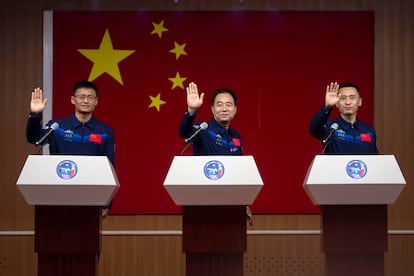China plans to land astronauts on moon before 2030
Beijing’s announcement comes amid against the background of a rivalry with the U.S. for reaching new milestones in outer space

China’s burgeoning space program plans to place astronauts on the moon before 2030 and expand the country’s orbiting space station, officials said Monday. Monday’s announcement comes amid against the background of a rivalry with the U.S. for reaching new milestones in outer space, reflecting their competition for influence on global events.
That has conjured up memories of the space race between the U.S. and the former Soviet Union in the 1960s and 1970s, although American spending, supply chains and capabilities are believed to give it a significant edge over China, at least for the present.
The U.S. aims to put astronauts back on the lunar surface by the end of 2025 as part of a renewed commitment to crewed missions, aided by private sector players such as SpaceX and Blue Origin.
The deputy director of China’s space agency confirmed the twin objectives at a news conference but gave no specific dates.
The agency also introduced three astronauts who will head to the country’s space station in a launch scheduled for Tuesday morning. They’ll replace a crew that’s been on the orbiting station for six months.
China is first preparing for a “short stay on the lunar surface and human-robotic joint exploration,” Deputy Director of the Chinese Manned Space Agency Lin Xiqiang told reporters at the rare briefing by the military-run program.
“We have a complete near-Earth human space station and human round-trip transportation system,” complemented by a process for selecting, training and supporting new astronauts, he said. A schedule of two crewed missions a year is “sufficient for carrying out our objectives,” Lin said.
The Tiangong space station was said to have been finished in November when the third section was added.
A fourth module will be launched “at an appropriate time to advance support for scientific experiments and provide the crew with improved working and living conditions,” Lin said.
The trio being launched aboard the Shenzhou 16 craft will overlap briefly with the three astronauts who have lived on the station for the previous six months conducting experiments and assembling equipment inside and outside the vehicle.
The fresh crew includes a civilian for the first time. All previous crew members have been in the People’s Liberation Army, the military wing of the country’s ruling Communist Party.
Gui Haichao, a professor at Beijing’s top aerospace research institute, will join mission commander Jing Haipeng and spacecraft engineer Zhu Yangzhu as the payload expert.
Speaking to media at the launch site outside the northwestern city of Jiuquan, Jing said the mission marked “a new stage of application and development,” in China’s space program.
“We firmly believe that the spring of China’s space science has arrived, and we have the determination, confidence, and ability to resolutely complete the mission,” said Jing, a major general who has made three previous space flights.
China’s first manned space mission in 2003 made it the third country after the USSR and the U.S. to put a person into space.
China built its own space station after it was excluded from the International Space Station, largely due to U.S. objections over the Chinese space programs’ intimate ties to the PLA.
Space is increasingly seen as a new area of competition between China and the United States — the world’s two largest economies and rivals for diplomatic and military influence — one a highly centralized, one party state, the other a democracy where the partisan divide largely evaporates over the issues of relations with China and space exploration.
The astronauts NASA sends to the moon by the end of 2025 will aim for the South Pole where permanently shadowed craters are believed to be packed with frozen water.
Plans for permanent crewed bases on the moon are also being considered by both countries, raising questions about rights and interests on the lunar surface. U.S. law tightly restricts cooperation between the two countries’ space programs and while China says it welcomes foreign collaborations, those have thus far been limited to scientific research.
Speaking Monday afternoon in Jiuquan, the technology director of the Chinese crewed space flight agency, Li Yingliang, said China hoped for more international collaboration, including with the U.S.
“Our country’s consistent stance is that as long as the goal is to utilize space for peaceful purposes, we are willing to cooperate and communicate with any country or aerospace organization,” Li said.
“Personally, I regret that the U.S. Congress has relevant motions banning cooperation in aerospace between the U.S. and China. I very much regret that personally,” he said.
In addition to their lunar programs, the U.S. and China have also landed rovers on Mars and Beijing plans to follow the U.S. in landing a spacecraft on an asteroid.
Other countries and organizations ranging from the India and the United Arab Emirates to Israel and the European Union are also planning lunar missions.
The U.S. sent six crewed missions to the moon between 1969 and 1972, three of which involved the use of a drivable lunar rover that China says it is now developing with tenders in the private sector.
While America currently operates more spaceports and has a far wider network of international and commercial partners than China, the Chinese program has proceeded in a steady and cautious manner reflecting the county’s vast increase in economic power and global influence since the 1980s.
Sign up for our weekly newsletter to get more English-language news coverage from EL PAÍS USA Edition
Tu suscripción se está usando en otro dispositivo
¿Quieres añadir otro usuario a tu suscripción?
Si continúas leyendo en este dispositivo, no se podrá leer en el otro.
FlechaTu suscripción se está usando en otro dispositivo y solo puedes acceder a EL PAÍS desde un dispositivo a la vez.
Si quieres compartir tu cuenta, cambia tu suscripción a la modalidad Premium, así podrás añadir otro usuario. Cada uno accederá con su propia cuenta de email, lo que os permitirá personalizar vuestra experiencia en EL PAÍS.
¿Tienes una suscripción de empresa? Accede aquí para contratar más cuentas.
En el caso de no saber quién está usando tu cuenta, te recomendamos cambiar tu contraseña aquí.
Si decides continuar compartiendo tu cuenta, este mensaje se mostrará en tu dispositivo y en el de la otra persona que está usando tu cuenta de forma indefinida, afectando a tu experiencia de lectura. Puedes consultar aquí los términos y condiciones de la suscripción digital.
More information
Archived In
Últimas noticias
The complicated life of Francesca Albanese: A rising figure in Italy but barred from every bank by Trump’s sanctions
Pinochet’s victims grapple with José Antonio Kast’s rise in Chile
Reinhard Genzel, Nobel laureate in physics: ‘One-minute videos will never give you the truth’
How Japan is trying to avert ‘digital defeat’
Most viewed
- Pablo Escobar’s hippos: A serious environmental problem, 40 years on
- Reinhard Genzel, Nobel laureate in physics: ‘One-minute videos will never give you the truth’
- Why we lost the habit of sleeping in two segments and how that changed our sense of time
- Charles Dubouloz, mountaineering star, retires at 36 with a farewell tour inspired by Walter Bonatti
- The Florida Keys tourist paradise is besieged by immigration agents: ‘We’ve never seen anything like this’










































